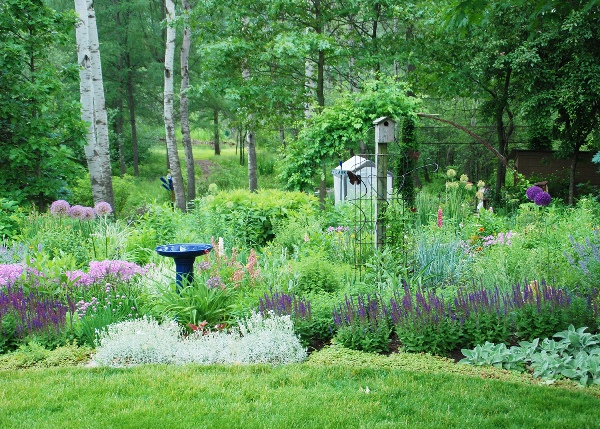We love watching rabbits hopping across the lawn or ground squirrels scurrying away with a cheek full of seeds; that is, until they dine on our favorite shrub or take just one bite out of each red ripe tomato in the garden. Finding a way to coexist is critical for wildlife struggling to survive and our enjoyment of nature and our landscapes.

As gardeners, we know that digging in the soil and tending a garden is good for our mind, body, and spirit. Researchers discovered the same is true when we take time to observe wildlife. Our need for a relationship with nature is also important to our wellbeing. It helps us feel more content and function more effectively.
But we love our gardens too. Implementing some design and management strategies can help us support and enjoy wildlife, care for our landscapes, and improve our quality of life.
Reducing the amount of edge habitat, where one type of habitat meets another, can allow us to support wildlife while reducing the risk of damage. Create circular or square garden beds that have more interior space and less border space; long linear beds with more edges and less interior space allows easier access for animals to dine.
Try working with neighbors and your community to create large blocks and corridors of habitat. Providing them spaces, other than your gardens, with needed food and shelter can help you and the wildlife to coexist.
Fencing is an option to protect key gardens and plants. Make sure your fence is high enough, tight to the ground, and has secure gates.
Repellents are a less obtrusive option. Select a product labeled for the animals and rodents you are trying to manage. For best results, apply repellents before the animals start feeding. Then reapply as recommended on the label. Look for one that is rain and snow resistant, requiring fewer repeat applications.
Work with nature to maintain a balance in your landscape. Invite hawks, owls, and fox to your backyard. Grow tall grasses and plants that provide cover for foxes. Include trees with good perches or install perch poles to attract and support raptors.
And like any landscape endeavor, start with a plan. Make a sketch of your existing landscape. Identify existing plants and wildlife-friendly habitats. Make note of natural habitats and any supplemental food, water, and shelter you will provide. Review and note various features in your landscape throughout the year.
Now decide what you want to accomplish in your landscape. What wildlife do you want to attract and have the space to support? Perhaps you want to attract more songbirds to your gardens or animals, like toads, that help manage pests in the garden.
Make sure your landscape provides the habitat features needed to attract and sustain these welcome residents. You will find lots of helpful resources on National Wildlife Federation, National Audubon Society, Natural Resources Conservation Service, your state’s Department of Natural Resources, and University Extension websites.
Be patient and wait for a year to evaluate the results of your efforts. Then begin making any needed changes to meet your goals.
Developing a landscape for you to enjoy and one that supports wildlife takes time, but as a gardener this can be not only part of the process but an exciting adventure.
Melinda Myers has written numerous books and hosts How to Grow Anything DVD series and the nationally-syndicated Melinda’s Garden Moment TV & radio program. Her website is MelindaMyers.com.
Related Articles & Free Vermont Maturity Subscription

Insider Tips to Boost Curb Appeal for your Home
Proper Landscaping Boosts Curb Appeal
Put Fall Leaves to Work in Your Landscape
Free Subscription to Vermont Maturity Magazine
Photo Courtesy of Melinda Myers






Comment here